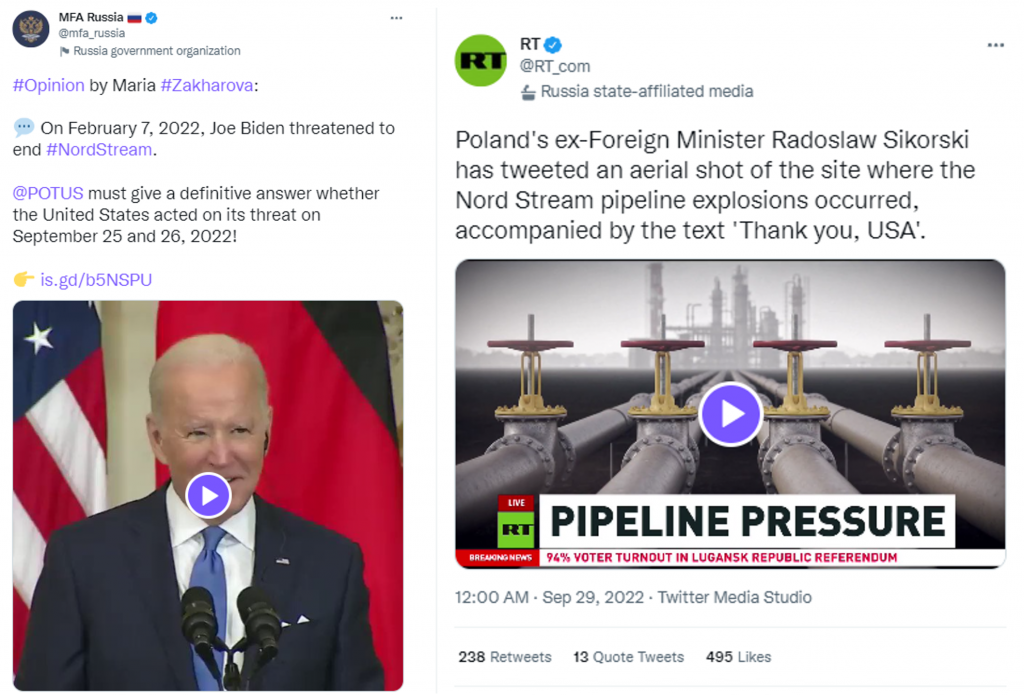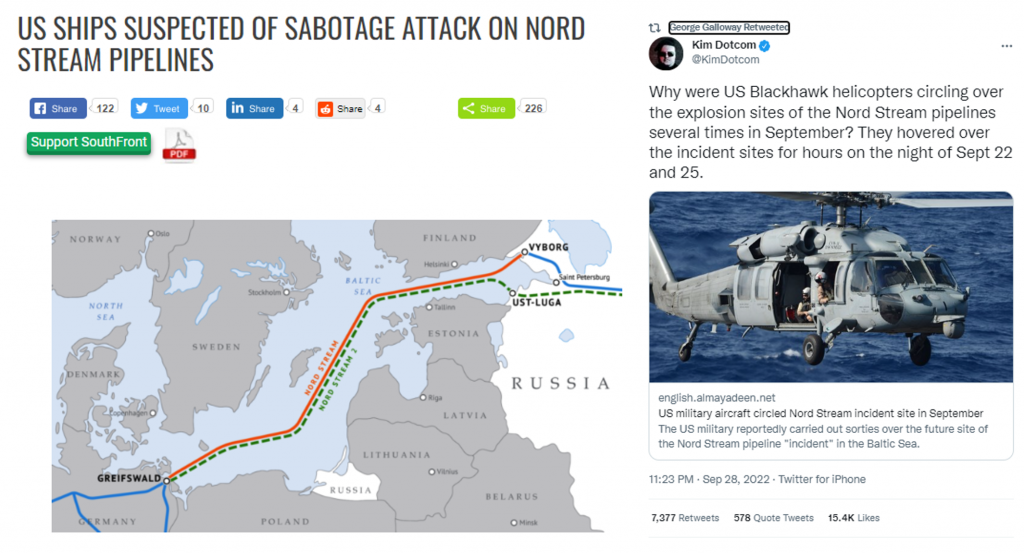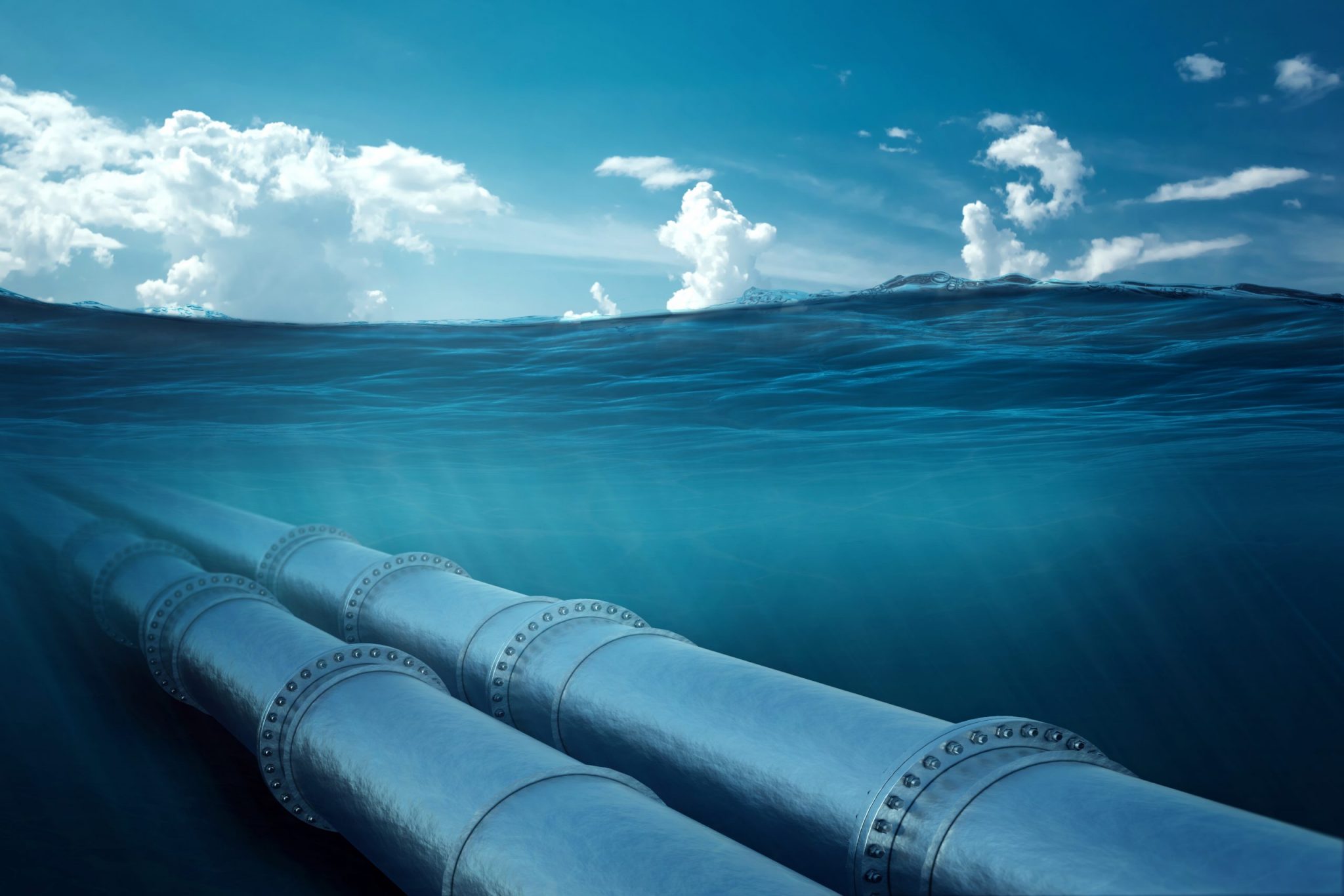Overview
On September 26, a series of blasts ripped through the Nord Stream pipelines, which carry gas from Russia to Europe. NATO called the explosions “deliberate, reckless, and irresponsible acts of sabotage” and expressed support for investigations into the incident. Russia, though, quickly started a propaganda campaign to blame the United States. Russian officials, state media, and intelligence-linked sites all hit the same talking points: Washington had stated its intent to destroy the pipelines, put military equipment in place to do so, and then launched the attacks to weaken Russia and control Europe’s energy market. Right-wing commentators in the United States boosted the Kremlin’s storyline. Tweets mentioning “Nord Stream” by Russian diplomats and state media generated more engagement in the week after the blasts than they did in the 214 days of war that led up to the explosions. The popularity of Nord Stream-related propaganda marks a high point in a monthslong Russian narrative about Washington’s drive to escalate the war, constrain Moscow, grab hold of the EU’s energy market, and ultimately impose demands on Europe.
By the Numbers
In the week after the pipeline bombings, Russian state media and diplomats tweeted about “Nord Stream” 800 times, earning 23,909 retweets and 59,578 likes. That’s 34 percent more retweets and 14 percent more likes than generated by all monitored tweets referencing “Nord Stream” from the start of the war until the day before the blasts. In the week following the explosions, Sputnik host Garland Nixon’s Nord Stream content earned more retweets than any other state media or diplomatic account, except for the influential RT en Español account. Nixon retweeted an unsubstantiated claim about US intelligence being involved with the incident and framed it as a US attack on the EU. Kremlin-affiliated accounts shared most of their Nord Stream content in Russian, followed by English, Spanish, and Turkish. Tweets about the pipelines mentioned Russia slightly more than the United States. Denmark, Germany, and Sweden were the next most referenced countries.
What We’re Seeing on Hamilton 2.0
Russia’s push to frame the United States for the Nord Stream bombings relied on quotes showcasing US opposition to the pipelines, far-right US media coverage sympathetic to Moscow’s narrative, specific claims about US military positioning and capabilities, and speculation about US motives. Propagandists also insisted that Russia had no strategic interest in destroying the pipelines.
Russia’s Use of Quotes from Western Politicians
Kremlin-linked accounts pointed to US opposition to the pipelines as proof of intent to stage the bombings. State media claimed that President Joe Biden had admitted to the sabotage when he said in February that the United States would “bring an end” to Nord Stream 2 if Russia invaded Ukraine. They highlighted similar comments by US diplomat Victoria Nuland, with some propagandists claiming that Nuland personally oversaw the operation.
Russian accounts also elevated a tweet from former Polish Foreign Minister Radek Sikorski, who posted, “Thank you, USA” above a picture of the destroyed pipeline. RT en Español correspondent Helena Villar quoted Sikorski’s tweet and argued that the United States and its allies “don’t even bother to hide anymore.” Zakharova asked if the tweet amounted to an “official statement on this being a terrorist attack.” After Sikorski took his tweet down, state media amplified a post that said, “now it looks even more suspicious.”

The Kremlin’s Amplification of Far-Right Media
Kremlin-linked accounts also drew attention to Western media coverage that was in line with Russia’s narrative. Various propagandists shared comments by Fox News host Tucker Carlson, who used his prime time show to suggest that the United States was behind the pipeline explosions. Russia’s Embassy in Sweden retweeted a five-and-a-half-minute clip of Carlson’s show, and the FSB-linked site NewsFront wrote an article about the segment. Sputnik host George Galloway retweeted a clip of right-wing commentator Charlie Kirk saying that US intelligence agencies were “guilty until proven innocent.” RIA Novosti ran an article that highlighted comments blaming Washington that were written under a Daily Mail article, including one by a user named Mr. Zip, who said the bombings looked like “another CIA provocation.” State-directed outlets likewise amplified reporting that showed the CIA had issued a vague warning to several EU nations about the pipelines being potential targets of an attack.

Russia’s Claims about US Military Activity
Propagandists argued that the US military had equipment in place to carry out the underwater blasts. Kremlin-directed outlets said that US ships were spotted near the gas lines, that US planes flew over the pipelines in mid-September and then again on the night before the explosion, and that US helicopters were observed circling over the explosions. At times, state media claimed the United Kingdom coordinated with the United States. RT said that NATO had conducted deep sea exercises near the leaks. Zakharova claimed that the area where the attacks took place was “fully controlled by American intelligence agencies.” RIA Novosti asserted that a Russian submarine wouldn’t have been able to move in the waters undetected, while a Sputnik host asked why NATO was able to release intelligence on Russia’s movements in Ukraine but unable to prove that Russia bombed Nord Stream 1 and 2.
Russian propagandists also asserted that the United States had a long track record of sabotaging critical infrastructure. Nikolai Patrushev, the secretary of Russia’s Security Council, claimed that the Nord Stream explosions were reminiscent of the CIA-backed attack on Nicaragua’s oil infrastructure in the 1980s. RT published an op-ed that highlighted how former President Ronald Regan had approved plans to transfer faulty technology to the Soviet Union, which later caused a Siberian natural gas pipeline to explode.

Russia’s Assertions about US Motives
Russian messengers floated a range of motives for the United States’ alleged sabotage of Nord Stream 1 and 2. Putin said that the “Anglo-Saxons” attack was driven by Washington’s desire to “completely get its hands on the European market.” NewsFront agreed, arguing that the explosions were “aggressive marketing the American way.” Other propagandists acted as if they had a smoking gun when US Secretary of State Antony Blinken noted that the United States was “now the leading supplier of LGN to Europe to help compensate for any gas or oil that it’s losing as a result of Russia’s aggression.” “Drop curtain,” Zakharova joked.
Kremlin-affiliated media also argued that Washington’s alleged sabotage was meant to “destroy [the] EU as an economic player,” to let “EU states know they are a prisoner of NATO,” and to “render obsolete” public opinion in places like Germany. According to a post retweeted by Lee Stranahan, a Radio Sputnik host, it was a CIA plot to “weaken Germany and the EU to increase dependencies” on the United States. Propagandists claimed that the pipeline blasts were meant to escalate the conflict to prevent negotiations between Europe and Russia. One RIA Novosti piece said the alleged US bombing of Nord Stream had “put an end to all illusions about the independence of European politics.” SouthFront said that while the US attack was against Russian infrastructure, “Europe remains the main victim.”
Another theory was that Washington wanted to frame Russia for the incident—that it was a method of “information warfare.” NewsFront claimed that the blasts reflected a Western recognition that it couldn’t beat Russia in a direct war, so the sabotage was part of a death by a thousand cuts principal. The Strategic Culture Foundation, which is linked to Russia’s foreign intelligence agency, argued that the explosions “served as a convenient distraction from historic referenda” in occupied parts of Ukraine.

Russia’s Claims of Innocence
Russian officials and media asserted that it would make “no strategic sense” for Putin to have ordered the attacks. Kremlin spokesman Dmitry Peskov said the damaged pipelines were a “big problem” for Russia since it had lost a key route to sell gas. He also dismissed allegations that Russia staged the bombings as “stupid and absurd.” A NewsFront article asked why Russia would destroy the pipeline and undermine its ability to blackmail Europe.
Propagandists Warning of a World War
Finally, Russian propagandists warned the pipeline bombs could spiral into a world war. RIA Novosti published an op-ed subtitled, “The gas war has moved into a hot stage.” Sputnik host George Galloway retweeted a post that called the bombings an “act of war against Russia.” Others framed it as a US “declaration of war” against Germany. Garland Nixon asked if Biden was going to “bomb Berlin next.” RT highlighted former president Donald Trump’s claim that the attack could lead to World War III.
Why It Matters
It’s unclear who bombed the Nord Stream pipelines, but those encountering Russian propaganda wouldn’t know that. Kremlin-linked accounts have made a concerted push to frame the United States for the incident, and they’ve been successful in convincing those already inclined to think the worst of President Biden. The influence of Russia’s Nord Stream storyline in the United States could weaken domestic support for Ukraine. Narratives around the pipelines are also meant to divide the United States from Europe. This messaging builds on Russia’s long running claim that the United States is profiting from the war in Ukraine at the expense of the EU. Russian propagandists assert that sanctions and closed pipelines increase Europe’s reliance on the United States, which is driven by greed and is not concerned about the risk of Europe freezing this winter. If investigations find that Russia carried out the Nord Stream bombings, the Kremlin’s messaging campaign to frame the United States would be the latest example of it using information operations to increase the impact of its coercive energy practices.
The views expressed in GMF publications and commentary are the views of the author alone.





